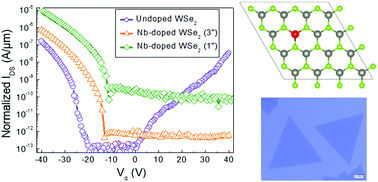Controlled p-type substitutional doping in large-area monolayer WSe2 crystals grown by chemical vapor deposition†
Abstract
Tungsten diselenide (WSe2) is a particularly interesting 2D material due to its p-type conductivity. Here we report a systematic single-step process to optimize crystal size by variation of multiple growth parameters resulting in hexagonal single crystals up to 165 μm wide. We then show that these large single crystals can be controllably in situ doped with the acceptor Niobium (Nb). First principles calculations suggest that substitutional Nb doping of W would yield p-doping with no gap trap states. When used as the active layer of a field effect transistor (FET), doped crystals exhibit conventional p-type behavior, rather than the ambipolar behaviour seen in undoped WSe2 FETs. Nb-doped WSe2 FETs yield a maximum field effect mobility of 116 cm2 V−1 s−1, slightly higher than its undoped counterpart, with an on/off ratio of 106. Doping reduces the contact resistance of WSe2, reaching a minimum value of 0.55 kΩ μm in WSe2 FETs. The areal density of holes in Nb-doped WSe2 is approximately double that of undoped WSe2, indicating that Nb doping is working as an effective acceptor. Doping concentration can be controlled over several orders of magnitudes, allowing it to be used to control: FET threshold voltage, FET off-state leakage, and contact resistance.



 Please wait while we load your content...
Please wait while we load your content...